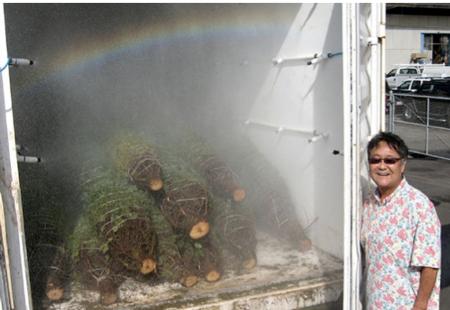Spring 2013: Hot Water Treatments to Control Pests
Regional Report San Diego and Riverside Counties by James A. Bethke
Although I only know one local grower that uses hot water to control major pests prior to shipping their product, Hawaii frequently uses the technique. You may be aware that cut flowers and foliage from Hawaii are dipped in hot water baths, but did you know that potted nursery stock can also be disinfested by hot water treatments? This has been achieved in commercial nurseries by retrofitting the cargo area of trailers into large shower stalls where the hot water treatments are applied. Dr. Arnold Hara, professor of entomology in the Department of Plant and Environmental Protection Sciences at the University of Hawaii in Manoa, helped develop effective hot water bath and hot water shower treatments against pests of quarantine significance on cut flowers and foliage, propagative material and potted plants. He has demonstrated that selected insects, invertebrates and vertebrates (Coqui frog) can be controlled with hot water and not harm plant material. Dr. Hara and his colleagues believe that quarantine hot water treatments can be adjusted to any specific risk level, including zero tolerance. The information below summarizes some of their work, but more details — including temperature and duration required to kill specific pest species, and photos of the bath and shower systems used in Hawaii — can be found in Dr. Hara’s presentation at the 2011 American Society of Horticultural Science (ASHS) meeting posted on his website at: http://www.ctahr.hawaii.edu/haraa/ASHSSystemsApproach092711Hara_rev%20%28NXPowerLite%20pptx%29.pdf .
Hot water bath. Dr. Hara has tested the hot water bath method on a number of plant species and found that immersion at 120.3°F for 1 to 10 minutes gave effective control of several species of insects, including aphids, scale, mealybugs and mites on nursery cuttings. Although the root mealybug is a very difficult to control or eliminate, hot water dips are as effective as insecticides against this pest. Experiments showed that submerging potted rhapis palms in water held at 120°F until the internal root ball temperature reached 115°F was 100 percent effective in killing root mealybugs.
Hot water shower. Dr. Hara and his colleagues created a small hot water shower unit and a larger hot water trailer for commercial application (fig. 1) and demonstrated that water sprayed at 113ºF for 5 minutes eliminates the coqui frog, an invasive pest in Hawaii. Heat damage to plants was reduced or eliminated by following the hot water shower with 1 to 2 minutes of cool water. Orchids and bromeliads were the only plants tested that were sensitive to the treatment. More information can be found at www.ctahr.hawaii.edu/coqui/documents/PosterAHaraFICCF.pdf

Fig. 1. Dr. Arnold Hara standing next to a potted nursery trailer that was recently used to disinfest Christmas trees (imported from Oregon) of slugs using a hot water shower treatment. Photo courtesy of A. Hara, University of Hawaii.
Another serious pest successfully treated with sprays of hot water is the magnolia white scale. Potted plants treated at 120°F water for 5, 5, and 6 minutes resulted in 100% mortality of adults, nymphs and crawlers, respectively.
Plant safety. Additional research on the plant safety of various temperatures demonstrated that most potted plants tested tolerated 113 to 120°F water for 5-, 10-, or 15-minute durations, with a few exceptions where new leaves and flowers were less heat tolerant. Tolerance of specific potted plant species to hot water treatments can be found in Dr. Hara’s ASHS presentation, as well as thermal tolerance of species used as propagative material, cut flowers and foliage, and landscape plants.
What About California?
My goal is to find out how this technology can be used in California through a multi-state research effort with Dr. Hara and Dr. Lance Osborne (University of Florida). We are seeking federal funding to construct hot water treatment containers to demonstrate efficacy, reduction in pesticide use and shipment of clean ornamental stock between our respective states. Our hope is that with a combined effort we can study the heat tolerances of a great many plants and pests. With an effective matrix, we will be able to tell growers how long to treat selected plants to provide 100% mortality of the pests without damaging the plants. We are working in concert with the USDA (Cindy McKenzie, USDA ARS Florida), who can help establish protocols and phytosanitary requirements, and with IR4 (Cristi Palmer, IR4 Rutgers), who is providing assistance with testing biological pesticides that can be applied during shipping. Look for more information in the future.
References
Hara AH, Jacobsen CM, Marr SR, and Niino-DuPonte RY. 2010. Hot water as a potential disinfestation treatment for an invasive anuran amphibian, the coqui frog, Eleutherodactylus coqui Thomas (Leptodactylidae), on potted plants. International Journal of Pest Management. 56(3): 255–263.
Gill S, Schuster C, Ross D, Rosenkranz G, Shrewsbury P, and Klick S. 2007. Keeping the heat on pests: Using a hot water immersion system effectively can control certain plant pests during propagation. American Nurseryman 205(1):22-32.
Hara AH, Niino-DuPonte RY, and Jacobsen CM. 2001. Root Mealybugs of Quarantine Significance in Hawaii. College of Tropical Agriculture and Human Resources. University of Hawaii Manoa, HI. Publication IP-6. 4p.
James A. Bethke
Farm Advisor, Nurseries and Floriculture
UC Cooperative Extension San Diego, North County Office
151 E. Carmel St., San Marcos, CA 92078
(760) 752-4715 phone, (760) 752-4725 fax
jabethke@ucdavis.edu
http://cesandiego.ucdavis.edu/












